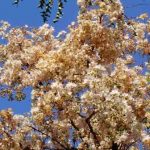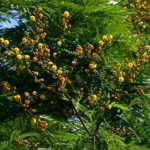TREE LIFE
JUNE 1994
We are now into the third month of our year, and if by some oversight you have not paid your $25 subs for the 1994/95-year, please do.
MASHONALAND CALENDAR
Saturday 4th June (WINTER). Botanic Garden Walk at 10.45 for 11.00 a.m. The Herbarium gates are locked during the weekends but there will be a security guard at the public car park and this is where we will meet Tom.
Sunday 19th June. Our intended venue at Wedza is very dry and suffering from early leaf drop so there is a switch to a riverine site on Mr. and Mrs. P Butler’s, Marsala farm off the Shamva Road. There are a good variety of trees, some not that common.
Saturday 25th June. Botanic Interest Walk; we meet Mark at Newlands Shopping Centre on the Enterprise Road in the car park near Squabbles Restaurant. Time 3 p.m. as usual.
Saturday 2nd July. Botanic Garden Walk
MATABELELAND CALENDAR
Sunday 5th June. An all day visit in the Fort Rixon Area so bring the usual life-sustaining essentials. We depart from Girls’ College at 8.30 and our first stop will be at Fort Rixon Club to look at its facilities and to get tea out of the way. The main interest is at ENGOMENI the Meikle’s Game Ranch set in miombo woodland and about 5 km from the club. If time permits in the afternoon, we will move on to Dlodlo Ruins, which are close by. The round trip is less than 200 km and the roads are quite good, with the first 47km on tar.
Sunday 3rd July. Aloe time in Nata; this will be a long all day trip.
Sunday 7th August. To Chesa Forest, which will most probably be an all day trip as well.
BOTANIC GARDEN WALK: 3 MAY 1994
Sapindaceae continued. The second instalment of the Sapindaceae began with the genus Allophylus.
This has compound leaves with 3 leaflets (trifoliate) and (often) has domatia present in the axils of the veins on the underside of the leaf. These appear as small pockets of hairs.
Five species were examined:
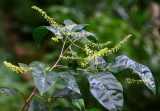
Allophylus chaunostachys. Photo: Bart Wursten. Source: Flora of Zimbabwe
- Allophylus chaunostachys is a shiny-leaved species of rain forests and occurs at low altitudes in Zimbabwe, for example at the Haroni/Rusitu confluence.
2. Allophylus alnifolius: Another species with shiny leaflets, this is a low-altitude species, occurring often in riverine vegetation.
3. Allophylus chirindensis: A very rare species of the Chirinda Forest with striking large leaflets, some over 15 cm long.
4. Allophylus africanus: This, of course, is the well-known species that is so common around Harare and which can easily be thought to be a Rhus. However, Rhus never have domatia and the fruit of a Rhus are usually flattened, whereas Allophylus fruits are not. Allophylus africanus has relatively hairy leaves, whereas the other four had more or less shiny leaves.
5. On to Allophylus abyssinicus, which we discussed last month, which occurs in disturbed sites (e.g.) in the Honde Valley. This species had the most striking domatia – enormous pockets easily visible to the naked eye.
Leaving Allophylus, we saw Zanha africana, with its pinnate leaves that lack a terminal leaflet (i.e. they are paripinnate). This is a well-known species occurring quite commonly on granite kopjies and in woodland. It is similar to the much rarer Zanha golungensis.
Pappea capensis, another common and readily recognisable species, often on granite kopjies and termite mounds, has simple leaves that are serrate. Often, on young leaves, the leaf edge is also spiny.
Pancovia golungensis has only been found in forests in the Burma Valley (in Zimbabwe) and is one of the rarest members of the family. Although Tom does have this in the Botanic Gardens, it is a very poor specimen.
We took another look at Stadmania oppositifolia, which has very shiny pinnate leaves. It occurs in the S of Zimbabwe – anywhere where there is an influence of guti – for example on Lone Star Ranch near Chiredzi. The bark is very smooth and the buds densely hairy.
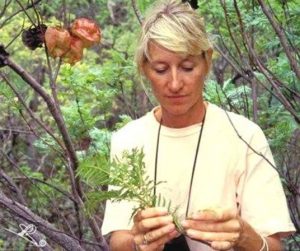
Erythrophysa transvaalensis. Photo: Richard Peak. Source: Flora of Zimbabwe
Finally, we saw Erythrophysa transvaalensis with its extraordinary inflated fruits, which are a bit like Cardiospermum a climbing species (also Sapindaceae). The leaves are pinnate and have a winged rhachis. This was only discovered in Zimbabwe about 8 years ago, having presumably been overlooked before.
Finally, to round off the evening, and finding ourselves in the Matabeleland section of the Gardens, we were shown some of the characteristic species of the Matopos.
Many thanks to Tom for another fascinating walk. Next month, Tom intends to look at the genus Rhus.
-Mark Hyde
Visit to new Road to Mazwi Game Reserve north of Bulawayo
On the 4th of April a pleasingly large turnout of people paid a visit to the new Road to Mazwi on a cool windy morning. In an area of cyanite/granite and mopane-clay an interesting array of species was encountered.
The good thing about tree society visits is that one always seems to learn something new on each trip. For example we were able to see that Combretum zeyheri and Combretum collinum sometimes have leaves inn whorls like the better-known Combretum adenogonium.
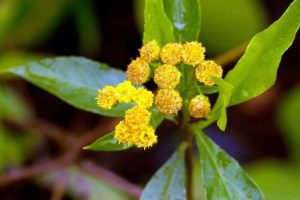
Psidia punctulata. Photo: Bart Wursten. Source: Flora of Zimbabwe
A new one for me was Psidia punctulata identified by Charles Sykes via Brian Best long ago. This is an interesting shrub in the Asteraceae, with yellow flowers and shiny resinous looking leaves.
The first stop yielded the following trees:
Acacia galpinii, Acacia gerrardii, Acacia nigrescens, Acacia nilotica, Albizia amara, Albizia tanganyicensis, Aloe excelsa, Azanza garckeana, Bridelia mollis, Canthium lactescens, Cassia abbreviata. Clerodendrum glabrum, Colophospermum mopane, Combretum apiculatum, Combretum collinum, Combretum molle, Combretum zeyheri. Commiphora mollis, Dichrostachys cinerea (several forms), Diplorhynchus condylocarpon, Euclea divinorum, Euclea natalensis, Euphorbia ingens. Ficus abutilifolia, Ficus glumosa, Ficus ingens, Ficus thonningii, Flacourtia indica, Flueggea virosa, Gardenia resiniflua, Gardenia ternifolia, Gardenia volkensii. Grewia bicolor, Grewia flavescens, Grewia monticola, Grewia retinervis, Kirkia acuminata, Lannea discolor, Maytenus senegalensis, Ozoroa insignis. Pappea capensis, Pavetta eylesii, Pavetta gardeniifolia, Pavetta schumanniana, Peltophorum africanum, Piliostigma thonningii, Pouzolzia mixta, Pseudolachnostylis maprouneifolia, Psydrax livida. Pterocarpus angolensis, Pterocarpus rotundifolius, Rhus leptodictya, Sclerocarya birrea, Strychnos madagascariensis, Terminalia sericea, Vangueria infausta, Vitex payos, Ximenia caffra, Ziziphus mucronata.
We then drove a little further down the road for lunch and tea after which some people went to other engagements. Seeing the additional spp. below rewarded those who stayed on.
Acacia ataxacantha, Acacia karroo, Combretum hereroense, Commiphora mossambicensis, Commiphora pyracanthoides, Croton gratissimus, Dalbergia melanoxylon, Elaeodendron matabelicum, Elephantorrhiza goetzei, Ochna holstii Ochna puberula, Tarchonanthus camphoratus, Terminalia randii, Terminalia brachystemma, Terminalia trichopoda, Ximenia americana.
An interesting day and worth another visit.Charles Sykes and Tom Raub did go back for another visit and were able to bring the tally up to 100 odd spp.
The following shrubs were also seen:
Cissus cornifolia, Dregea macrantha (a climber), Jasminum sp., Maytenus heterophylla, Psidia punctulata, Rhigozum obovatum.
Succulents seen included
Aloe aculeata, Aloe chabaudii, Aloe greatheadii Euphorbia espinosa Euphorbia griseola Euphorbia schinzii
-Anthon Ellert
RENCO MINE Saturday 16th April
We had been warned that the access road to Renco Mine, situated in a largely forgotten corner of Zimbabwe, was rough so it was a relief to stop and consult the notice board at the mine gate. Investigating one of the many very green shrubs nearby, Maureen returned triumphant with a cluster of the unusual paired fruits belonging to the Toad Tree – Tabernaemontana elegans.
The football grounds seemed an unlikely place to pitch tents but it served us well and towards evening the familiar potato smell of Phyllanthus reticulatus wafted over the campsite while we persuaded reluctant tent pegs to penetrate the hard ground. Tessa’s tent took full marks as the small onion like domes on each end resembled something out of Arabian Knights! However, during the night hours some tension was created as the banshee howl of the mine shift change siren echoed over the (slumbering?) campers on the football field!
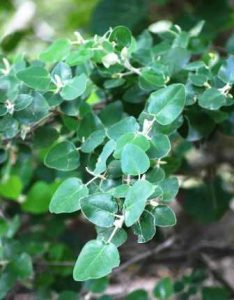
Androstachys johnsonii. Photo: Bart Wursten. Source: Flora of Zimbabwe
As the Nyoni Hills were an hour’s drive away we headed out the following morning stopping en route next to the Tokwe River where we found a couple of Androstachys johnsonii (ironwood). A really interesting find as Tom Muller had given Mark a specimen a few days before and it was exciting to see the dark green heart shaped leaves with white underside and the young terminal leaflets looking like a pair of tiny cupped hands. As an aside it was pleasing to note that the mini-soccer machine, on which Tom Muller challenged the locals to a game, on a previous Tree Soc. visit, was still in place.
The road wound its way up into the hills passing thickets of Acacia schweinfurthii well covered with pods and the odd Baobab before stopping a short distance past an unexpected microwave tower. Moving in and out the rather patchy Miombo woodland we came across another of the Euphorbiaceae family, this time Alchornea laxiflora which had large rounded leaves and a pronounced “drip tip”. Another feature was the pair of hairs or glands at the junction of the leaf and petiole. Another new one to me was Cordia grandicalyx, which sounded impressive, but the name refers to its unusual calyx and as expected no fruit or flowers could be found.
From our vantage point on the granite whaleback we were able to have a good look out over the lowveld heading away in the direction of the mine, some 40 km due west, with the shallow Tokwe River meandering its way south west through increasingly arid country. Until now the lowveld temperatures had been kind to us but after fifteen minutes in the full sun, the idea of lunch in the deep shade was too much to resist. Another find on the way down was a colony of shrubby Maytenus mossambicensis, where the clusters of small serrated leaves masked the long red spines, interesting to look at but bad news for the fingers! More Tabernaemontana elegans appeared, the mature ones having a surprisingly corky bark and in a rock crack we noticed the wavy margined leaves of a Ficus tettensis.
Some interesting after lunch finds were Stadmania oppositifolia, one of the Sapindaceae family with opposite leaves of an almost green lacquer colour and the more familiar Rhus chirindensis at home in the hilly terrain.
Our slower than normal progress (that’s really something!) was halted when Tessa emerged down the road clutching an armful of foliage in which lurked a few leaves with alternate leaflets that we had not yet seen. Possibly the colour but most likely the long drip tip stimulated the few to think of Calantica jalbertii. It would have been a shame to have come all this way and not see it on its home ground.
An exciting but also confusing day with so many specials popping up in an area that few of us have the opportunity to wander in and we recorded 80 different species, pretty good for an area of about a square kilometre!
-Andy Macnaughtan
SUNDAY 17 APRIL 1994: BANGALA DAM
The plan for the day was to visit Bangala Dam and Linda, with her usual efficiency, had mapped out our route in, as well as offering alternative returns.
The dirt road took us from Renco to Musvosvi then eastwards and north via Bangala Mission to the dam wall, where we were delighted to find an oasis of green lawns, shady pergolas and spreading trees (Erythrina lysistemon, Poinciana regis and Ficus lutea, all probably introduced). These attractive gardens, perched high on the hill slope on the west bank, give a commanding view of the dam wall and surround the water bailiff’s complex. Unfortunately this official was away, so we retraced oar steps and took a track below the bailiff’s house from where we botanised on the hillside and downstream along the Mutirikwe. The left bank of the river was denied to us because the outlet at the base of the dam wall was open and a great plume of water arching from this point, sent a flood downstream, filling the channel from bank to bank. The intrepid could of course reach the other side at the risk of a $2 000 fine and a vertiginous crossing of the Bangala wall and spillway. The former deterrent is obviously not applicable to the locals, one of whom made the crossing bearing a loaf of bread.
Many familiar species included Acacia nigrescens, Brachystegia glaucescens and Brachystegia spiciformis, Colophospermum mopane, Ficus abutilifolia, Kigelia africana, Kirkia acuminata, Ormocarpum trichocarpum. And exciting new finds were Coffea racemosa, Dombeya kirkii in bloom, Ficus capreifolia with sandpaper leaves, Holarrhena pubescens, Pteleopsis myrtifolia, Spirostachys africana, Ximenia caffra var. natalensis, Androstachys johnsonii. Maytenus mossambicensis, with soft autumn coloured leaves and bright pink fruit arid Vitex ferruginea subsp. amboniensis with fruit the size of plum tomatoes.
Two-and-a-half hours of work gave us 75 species, by which time the temperature had soared to the mid-thirties and dehydration and fatigue drove us back to the garden. Here we lolled in the deep shade of a pergola, eating, drinking Andy’s most welcome iced cokes, dozing, or poring over our botanical souvenirs till mid-afternoon. Then we returned to the mine, some via Nyikavanhu to rejoin the main Triangle road at the 42 km peg and the rest backtracking on the morning’s route.
An interesting and rewarding day and wonderful to be with our Mashonaland counterparts once again. Thank you for inviting us.
-Ian and Margaret McCausland
MONDAY 18th APRIL – RENCO MINE
Monday found us ambling in the hills behind the mine workings and with the changing terrain from rock faces to well wooded gullies, the day was full of surprises.
The shallow soil pockets on a rock face were home to an exciting find – an Apocynaceae named Strophanthus kombe (also called the Zambezi Tail flower). The few remaining obovate leaves covered in stellate hairs were nothing compared to the pairs of long cylindrical pods tilted upwards at a rakish angle. Teclea trichocarpa was of the few Rutaceae recorded and as always meddling fingers damaged the hundreds of tiny pellucid glands in the trifoliate leaf so producing the characteristic citrus smell.
Another set of unusual green leaves was almost enough to trigger an attack of arboreal haze but the highly distinctive veining from the base of the leaves made satisfying identity for Strychnos mitis. We had seen this the previous day growing with a Berchemia discolor near the mine tavern, where our seed collecting created great excitement to both children and imbibers from the nearby bar.
Afternoon meanderings along the riverine fringe of the Garutsime River produced an interesting mix of more familiar species (at last!) such as the smooth grey barked Trema orientalis a Ximenia caffra var. natalensis, easily recognised, as the young leaflets were hairless. Another new one for the day was Coddia rudis, shrub-like and scattered along the riverbank.
As the afternoon drew to a close we trundled back to the mine casting wary looks at the massive bags of specimens which attempted to break free every few minutes when the Landcruiser vibrated its way over the corrugations.
We had a really fantastic time at Renco Mine and despite the ants that felt they should also share tent space; the football-pitch was a really convenient spot (3 loo’s and 10 showers!). Very many thanks to the Management of Renco for arranging our stay.
-Andy Macnaughtan
BULAWAYO TREE SOCIETY
With an ample collection of octogenarians, septuagenarians, one infant, and other folk, the Bulawayo Tree Society proceeded 65 kilometres on the Harare Road to the home of the Brownlee-Walkers. To counter the coolish May 1st weather, the warmth of Mr. and Mrs. Brownlee-Walker, whose courtesy and hospitality made our morning teatime most enjoyable, augmented the warmth of the sun. The Bulawayo Tree Society had been invited by the Brownlee-Walkers two years previously, but after many postponements and cancellations the visit became possible.
At our first stop, we found Acacia rehmanniana, Carissa edulis, and an old an acquaintance, Carissa bispinosa, and to some of the newer members, a new discovery Balanites aegyptiaca. This led to a discussion of the differentiation of Balanites aegyptiaca and Balanites maughamii.
At the next stop on this 15 000 acre cattle farm, we disembarked to be informed that the farm was first occupied in 1912 and that where we were standing, evidence had disclosed of a large settlement of indigenous people. They had been present from the latter part of the 19th to the early part of the 20th century. It was further pointed out that the present water supply would not sustain a large population now, corroborating what people in Bulawayo suspect, that the climate is changing.
Further peregrination along a fence brought our attention to large numbers of shrubs and Burkea africana, Albizia antunesiana, Combretum molle, Dichrostachys cinerea, Ziziphus mucronata, two species of Terminalia, Terminalia sericea and Terminalia brachystemma, and 3 species of Grewia. Several larger specimens of Albizia amara, Acacia karroo and Acacia robusta, Combretum apiculatum and Combretum hereroense, Diplorhynchus condylocarpon. Euclea divinorum and Euclea racemosa, Peltophorum africanum, Combretum hereroense, Rhus lancea and Rhus tenuinervis along with Parinari curatellifolia, and many others. Only one Securidaca longipedunculata was seen, isolated Ozoroa insignis, Pavetta schumanniana, Vitex payos, Piliostigma thonningii, Sclerocarya birrea and others were encountered. Extended discussion followed concerning differentiation between Grewia bicolor and Grewia monticola. One comment was introduced “Grewia bicolor resembles soldiers in line, standing straight parallel, and at attention.” The Terminalia discussion centred around the decurrent leaf base of Terminalia brachystemma.
The fence prevented anyone from getting lost, an occurrence not unheard of in our Society. We gradually meandered back, having segregated into small groups, in which we remained to find shady areas for lunch. The tallest Grewia monticola and Elaeodendron matabelicum tree that our group had ever encountered – 6 to 8 meters – a Kirkia acuminata and many others generated our shade.
The best was yet to come, for after driving to another area, the savannah-like grassland was pocketed by verdant tree growth. Questioning the case of this more luxuriant growth, we were informed that this might have been initiated by termitaria and/or a higher water table. Investigation of these pockets revealed a winter Cassia (Senna singueana) about to burst into bloom, Lannea discolor, a Clerodendrum glabrum taller than we have previously seen (6 to 8 meters), a Kirkia acuminata, and many others.
Crossing a small, dry rivulet, we approached a large, heavily fruited Gardenia volkensii, which yielded enough material for our members to seed their gardens. Further search revealed a Bolusanthus speciosus which was large, high, rounded and with pendent branches. Too bad we did not bring our camera. Then came this writer’s most important discovery – an Albizia harveyi, too tall to recover any fruit or leaves (however, someone directed me to a source in Bulawayo). My arrival just before nightfall necessitated a morning sojourn to capture some leaves and pods for microscopic study.
A location was found for afternoon tea and for tabulation and discussion of species. The intensity and mental alacrity of our group could not be dampened by the presence of what we in the United States of America would term buffalo chips . In fact, due to this retained intensity, even at closing time, these “chips” were not even noticed.
This illustrates why I feel this group must be the most portentous in Zimbabwe.
Oh yes, we came across a moulted mamba skin, saw a soaring Bateleur eagle, spied a diminutive Psydrax livida almost hidden behind a rock, marvelled at the afternoon sun shining on fruit of Russet bush willow. Wondered in amazement why the massive number of Albizia amara legumes did not overpopulate the universe, and left the Brownlee-Walker’s ranch at peace with the world.
May we return – please?
-Tom Raub
THORA’S HERBAL REMEDIES
Soapwort, Bouncing Bet, Australian Creeping phlox – Saponaria officinalis
Mention made of the saponins in the last issue of Tree Life, brings to mind that wonderful cleansing plant, which is very invasive in the Garden. Instead of cursing it, use it and bless it for it’s many and varied uses.
Soapwort or Bouncing Bet (so called, because the women in times past used to bounce up and down doing their weekly washing) grows easily in any soil and throughout the summer sends up dense heads of pretty pink phlox-like flowers in either single or double form.
The roots, stems, leaves and flowers can be put into a large pot, covered with water and brought to the boil for 15 minutes. The resultant brew should be left to cool and then strained. The soapy green liquid can then be frothed up and used. We were present when Ken’s cousin did her weekly washing with It and her bed linen and towels came out beautifully clean and wonderfully soft. Her hands too benefited from the experience as soapwort has a remarkable soothing and softening action on the skin, but of course there are some people with very sensitive and allergic skins so a simple skin test may be necessary at first.
The brew cleanses everything; linen, woollen materials before dyeing, fabrics with delicate colours, precious woven hangings and tapestries. It is excellent for cleaning carpets.
Saponaria is also the homeopathic remedy prescribed in the treatment of all skin ailments, scabbing, acne, pimples, urticaria, rheumatism and gout. Arab doctors prescribed it for ulcers and leprosy.
Two cups of soapwort leaves and flowers boiled in a litre of water for a minute or two is a good wash for rashes, sunburn and eczema. The same brew can be used as a dab on lotion for cuts, scrapes and grazes. The deep soothing action will clean a wound and promote healing.
This same brew can also be used as a hair rinse and conditioner especially for dry, brittle, over-permed and unmanageable hair. Wash the hair in the normal way, rinse and then soak the hair in a soapwort brew, massaging it into the scalp for 7-8 minutes. Rinse and dry and you’ll notice a remarkable difference.
Used in the bath it soothes, smoothes and softens the skin. Try it after a hot day in the sun. Dogs, cats and horses can be bathed with the brew to clear up eczema and to keep their hair/fur soft, silky and shiny.
Houseplants can be sprayed with it to keep them free of dust and fungus attacks.
Plant lice and mildew vanish with a weekly wash.
When the plants in the garden begin to get straggly and untidy, cut them right back and place the cuttings on the compost heap. They break down very quickly.
Dicerocaryum zanguebarium
The name is derived, from the Greek words meaning two-horned fruit from Zanzibar.
This is a common trailing annual found growing in the grass of our sandveld. It has a thick woody rootstock, lobed leaves which grow opposite each other and very pretty pink-mauve tubular foxglove-like flowers. The fruit is a flattened disc with two hard prongs or spines on the upper surface. They look like boot protectors or studs and the spines are a good means of dispersal.
The leaves, flowers, stems and roots soaked for 24 hours or boiled in water make an excellent soap substitute or hair shampoo used by the Africans.
The liquid is used to baths babies suffering from measles and to facilitate a difficult birth in livestock.
The leaves are edible and are cooked like spinach.
-THORA HARTLEY
NYARUPINDA CATCHMENT
The Scene
Everyone is talking about water, day by day there is less to share out for irrigation. The bush has dried up, there are birds visiting the garden that were not seen last year, Heuglin’s Robins have been very loudly melodious at the streak of dawn. They have taken a long time to find the water in this garden on a stony hillside.
April 27th 1994
This day will always be remembered because it was spent with 16 children and a few grownups at Muzunga Dam SS. Ranch, Raffingora. The dam, teeming with life, is on the Madziwe River in the Manyame catchment.
The day’s programme began with a run, after breakfast there was a walk to see rock paintings. Andy Bone, a well-known artist, spoke about rock art and the San artists.
On returning to the Bush Camp we sketched from memory two human figures and one animal bushman style, which meant that rubbing out was not allowed. After inspecting all the pictures Andy said all of us had made the heads too big, this exercise proved how difficult it was to draw what we had seen. At the rock art site we saw three short red parallel lines among the figures in the frieze, those are said to symbolise rain. These lines are not uncommon, who has seen them?
Vitex payos on the kopjies bore ripe brown fruit, when told it was Chocolate Berry tree the children exclaimed yummy this changed to yuck when they tasted the fruit.
After lunch and a rest some children helped me to arrange a Nature Study Display of the following items. Fruits of Combretum hereroense and Acacia albida, (Faidherbia albida); two cylinders of wood from fire-resistant Indigenous trees to show their thick bark e.g. Acacia amythethophylla and Parinari curatellifolia; nests of a Penduline Tit and a tailor bird be it of a warbler, Prinia or Cisticola. A Scimitar-billed Wood hoopoe (recently found dead in the garden); a Mantis nest on Swamp Couch Grass; a Carder bee, Serapista sp. whose body is black and white, beside its woolly nest; ‘ear feathers’ from a Scops Owl, accidentally killed. Pieces of wood bearing a white and a small brilliant orange-coloured bracket fungus. Regarding fungi it is necessary to digress here to pass on some information, which may interest readers who went to school a long tine ago. “Fungi are a group of organisms that were at one time classified in the Plant Kingdom (and still are by some botanists). Most mycologists now place them in a separate Kingdom, Mycota … they differ from plants in that they have neither chlorophyll nor a root system”. This information comes from C. Sharp’s article Edible and Poisonous Fungi in Zimbabwe, “Science News”, July/August 1983.
There was another fungus exhibit, a portion of fungus garden from a termitarium together with a photograph of a partially demolished termite mound showing the ‘garden’ in situ. A Raffia Palm fruit and a photo of a Bark Spider completed the Exhibit.
The Quiz
It was a challenge planning the Quiz for the children who attended the Bush Camp because their ages ranged from 8-14 years. Inspiration came from Rhodesian Knowledge (which began in 1976) and from Bush beat a supplement to Zimbabwe Wildlife and resulted in 16 questions that totalled 36 points. The best scores were 27 and 26 points so it was quite difficult for them but not gloomy because there were some fun questions. On the question paper there was a column for corrections and the answers were put on the blackboard so as to satisfy the keen children and inform the others.
What was the name of the trees, which grew beside the “great Grey-green greasy Limpopo River?” What is another name for these trees?” The head of an animal is the symbol of the Wildlife Society of Zimbabwe, what is it, what is the message under it? What is a badminton bird? Name the pair of animals running through the centre of Harare. Name four of the sculptured animals beside the Queen Victoria Museum in Harare, what food is eaten by each of them?
When bats excrete they hang by their thumb claws to avoid polluting themselves, true or false? Herpetology is the study of a certain groups of animals, what are they? The answer was reptiles and amphibians, in the discussion during corrections the children, quite rightly, included dinosaurs.
After Tea and lots of Biscuits
A stroll to the dam, a few metres from the camp, to look for aquatic insects rounded off the day. This was interesting because the children had received photo copied illustrations of Insects at the Water’s Edge, which accompanied an article by EH Pinhey, in Wild Rhodesia No. 8. The ‘star’ insect found was a Whirligig Beetle, which writes on the water and has two eyes to see above the surface and two eyes keeping watch below. A magnifying glass provided a lot of entertainment, and we saw parasites on these beetles.
Feretia aeruginescens This tree is fruiting now and is very decorative with crimson berries closely spaced along the branches. The fruit is this tree’s label; it has a white circular scar edged with four or five black points, the remains of the calyx.
Travellers to Kariba have noticed Feretia close to the road about 20 km from Makuti on the escarpment side.
-Benedicta Graves
ANDY MACNAUGHTAN CHAIRMAN


